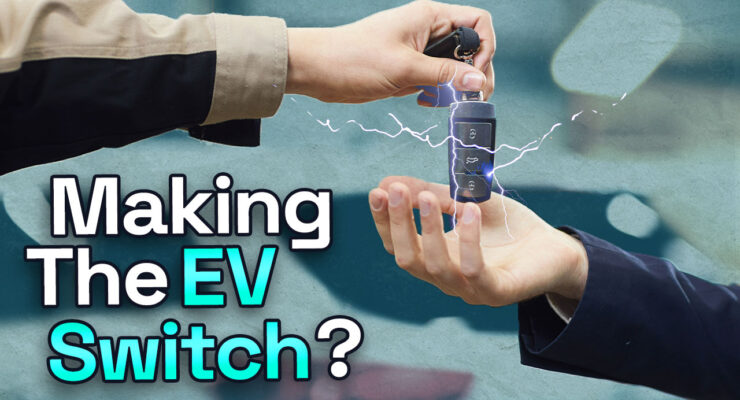Fast read
To encourage the shift towards electric vehicles (EVs), cities can offer financial incentives, such as tax breaks and exemptions from tolls, and inform the public about the benefits of EVs to dispel myths and address range anxiety.
Pricing signals, such as alerts to charge vehicles when power is cheapest, can also encourage uptake.
Convenience incentives like free or priority parking for EVs, more public charging stations, and bus lane usage for EVs can also help.
Additionally, governments can electrify public transport to have the biggest impact on emissions reduction.
While cheaper batteries are needed to make EVs more affordable in the long term, implementing these incentives and measures can boost EV uptake and usage in the meantime.
How do we encourage electric vehicle adoption in Australia?
Electric vehicles are expected to be the future of vehicles and replace combustion engines. Australia is behind many other OECD countries in electric vehicle adoption. But how can we get Australia on track and encourage electric vehicle adoption?
One way cities can reduce their transport emissions is by shifting towards electric transport, specifically electric vehicles. However, several different electric vehicle brands and models are available for customers worldwide. Sales of these vehicles still need to be faster than gas-powered vehicles.
The primary way we can improve electric vehicle usage is cheaper batteries, making electric vehicles more affordable. For now, there are still many different ways that we can encourage electric vehicle adoption. They are:
Financial incentives
Electric vehicles are expected to have an upfront cost competitiveness within the next ten years with gas-powered vehicles. However, in the meantime, one way that we can encourage electric vehicle adoption is through government incentives to lower the ownership and upfront costs of EVs. Some examples of what this could look like are:
- Exemptions from road tolls: Cities can exempt electric vehicles from certain road tolls. In London, drivers with an electric vehicle don’t have to pay the congestion charge, which has led to more EV use. This simple step could be taken globally and significantly impact how many electric vehicles are on our roads.
- Tax breaks: Like the available solar rebate, governments could offer rebates or tax incentives to lower the cost of buying and leasing electric vehicles. This is proven as a significant way to influence EV usage. These incentives existed in Atlanta, a city in Georgia, USA. When it was revoked, it caused a 90% decrease in EV sales for some time.
- Scrappage schemes: Introducing scrappage schemes for gas-powered vehicles and introducing low-emission driving zones can help make converting to electric vehicles easier. While also aiming to reduce the amount of gas-powered cars on the road.
- Convert taxis: Taxi businesses should be incentivised to convert all new taxi cars to electric vehicles. This will positively affect emissions, and some people may change their opinion on EVs after being in one.
Inform the public to increase electric vehicle adoption
A lot of people have heard and know about electric vehicles, however, if you ask them specific questions about the benefits of these vehicles compared to gas-powered vehicles, only some can give you a detailed answer. A simple way to increase electric vehicle usage is to get governments to run awareness campaigns on TV. This can explore many myths surrounding EVs, especially regarding their battery life and range.
One of the main reasons there has been in the past a relatively low adoption of electric vehicles could be because drivers are scared that they will run out of range while on the road, known as range anxiety. This is a common misconception that needs to be updated. Since there are many options in the Australian EV market, they can quickly meet the needs of most drivers.
Pricing signals
Many people nowadays have an app on their phone which can tell them where the cheapest petrol station is from their location. This simple concept is being developed for EVs but still needs some work. Electric vehicle manufacturers can encourage adoption by informing drivers when power is the cheapest.
BMW has started this with their smart charging app. The app gives drivers the best time to charge their vehicles. If people knew they could charge their cars for less money, more people would use electric vehicles.
Convenience incentives
Another significant way to encourage electric vehicle adoption isn’t through financial incentives but convenience incentives. This would come in the shape of a few different concepts:
- Free parking: One problem many of us face in busy cities is finding a car park. We encourage the shift from gas-powered vehicles by offering free or priority parking to EVs. However, this must be taken with precaution as it may also promote a change from public transport to vehicle use. So it should only be implemented in areas with less public transport.
- Bus lane usage: We have all been in traffic before and thought about getting in the bus lane to skip the queue. By allowing electric vehicle drivers to bypass traffic, adoption will increase. However, this may be revoked if uptake rises too much.

More public charging infrastructure will increase electric vehicle adoption
Access to the infrastructure for charging electric vehicles is one of the public’s main worries. Governments and companies need to create more charging stations in cities, on roads, and in public parking lots. This will help improve accessibility for electric vehicle charging.
By increasing the number of EV charging stations, it will be easier for people to charge their electric vehicles. This will ultimately help solve the problem of electric vehicle charging accessibility.
Businesses might receive incentives for adding charging stations, assuring easy access for EV consumers by utilising current electrical infrastructure. Utility company collaborations can make it even easier to construct fast charging stations.
Electrify public transport
Governments can transition towards electric vehicles by converting what they control, such as buses and trains. These modes of public transport will also have the most significant impact on minimising emissions as they travel much further than individual vehicles.
Top-brand car manufacturers like Bentley, Jaguar and Ford are pledging to be fully electric by 2030. Manufacturers support electric cars, but government and cost are barriers to cities becoming fully electric.
The use of electric vehicles must be encouraged through a complex strategy that includes fleet electrification, the development of charging infrastructure, financial incentives, public awareness campaigns, supportive laws, and cooperation with the automobile sector. We can speed up the shift to a sustainable transportation system by using these strategies. This will also bring benefits such as reduced emissions and improved air quality.


